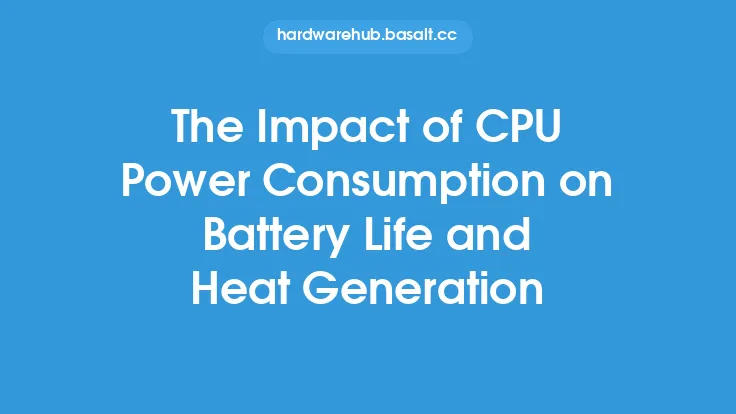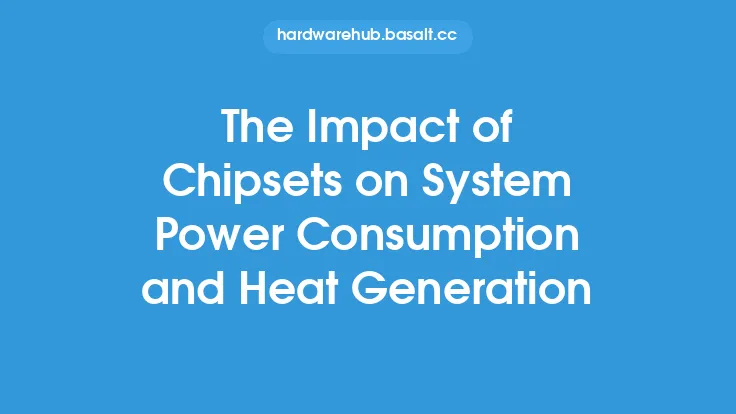The central processing unit (CPU) is a critical component of modern computing systems, responsible for executing instructions and handling tasks. One of the key technologies that has improved CPU performance in recent years is CPU Turbo Boost, which allows the processor to temporarily increase its clock speed above its base frequency. However, this increase in performance comes with a cost, as it also affects power consumption and heat generation. In this article, we will delve into the impact of CPU Turbo Boost on power consumption and heat generation, exploring the technical aspects and implications for system design and operation.
Introduction to CPU Turbo Boost
CPU Turbo Boost is a technology developed by Intel that enables the processor to dynamically adjust its clock speed based on the workload. When the system is running a demanding application, the CPU can increase its clock speed to improve performance. This is achieved by adjusting the CPU's voltage and frequency, allowing it to operate at a higher performance level. The amount of increase in clock speed depends on the specific CPU model, cooling system, and power delivery.
Power Consumption
When the CPU operates in Turbo Boost mode, its power consumption increases significantly. This is because the CPU requires more power to maintain the higher clock speed. The increase in power consumption is due to the higher voltage and current required to drive the transistors at the increased frequency. As a result, the CPU's power consumption can increase by 10-20% or more, depending on the specific implementation and workload. This increase in power consumption can lead to higher energy costs and reduced battery life in mobile devices.
Heat Generation
The increased power consumption during Turbo Boost operation also leads to higher heat generation. As the CPU operates at a higher frequency and voltage, it generates more heat due to the increased current flow and switching activity. This can cause the CPU temperature to rise, which can lead to reduced performance, increased fan noise, and decreased system reliability. If the heat is not properly managed, it can also lead to thermal throttling, where the CPU reduces its performance to prevent overheating.
Thermal Design Power (TDP)
The Thermal Design Power (TDP) is a critical parameter that determines the maximum power consumption and heat generation of a CPU. TDP is the maximum power that a CPU can consume while operating within its specified temperature range. When a CPU operates in Turbo Boost mode, its TDP can increase significantly, requiring a more robust cooling system to manage the heat. For example, a CPU with a TDP of 95W may consume up to 140W or more during Turbo Boost operation, requiring a high-performance cooling system to prevent overheating.
Cooling System Design
The cooling system design plays a critical role in managing the heat generated during Turbo Boost operation. A well-designed cooling system can help to mitigate the effects of increased heat generation, ensuring that the CPU operates within its specified temperature range. This can include the use of high-performance heat sinks, fans, and liquid cooling systems. Additionally, some systems may employ advanced cooling techniques, such as heat pipes or vapor chambers, to improve heat transfer and reduce temperatures.
Power Delivery
The power delivery system is also critical in supporting Turbo Boost operation. The power delivery system must be able to provide the increased power required by the CPU during Turbo Boost operation. This can include the use of high-performance voltage regulators, capacitors, and inductors to filter and regulate the power supply. Additionally, some systems may employ advanced power management techniques, such as dynamic voltage and frequency scaling, to optimize power delivery and reduce energy consumption.
System Implications
The impact of CPU Turbo Boost on power consumption and heat generation has significant implications for system design and operation. System designers must carefully balance the need for high performance with the requirements for power efficiency and thermal management. This can include the use of advanced materials, such as copper or graphite, to improve heat transfer and reduce temperatures. Additionally, system designers may employ techniques such as clock gating, power gating, and dynamic voltage and frequency scaling to reduce power consumption and heat generation.
Conclusion
In conclusion, CPU Turbo Boost has a significant impact on power consumption and heat generation. While it provides a significant boost to system performance, it also requires careful management of power delivery and thermal design. System designers must balance the need for high performance with the requirements for power efficiency and thermal management, employing advanced techniques and materials to mitigate the effects of increased heat generation. By understanding the technical aspects of CPU Turbo Boost and its impact on power consumption and heat generation, system designers can create high-performance systems that are both efficient and reliable.





